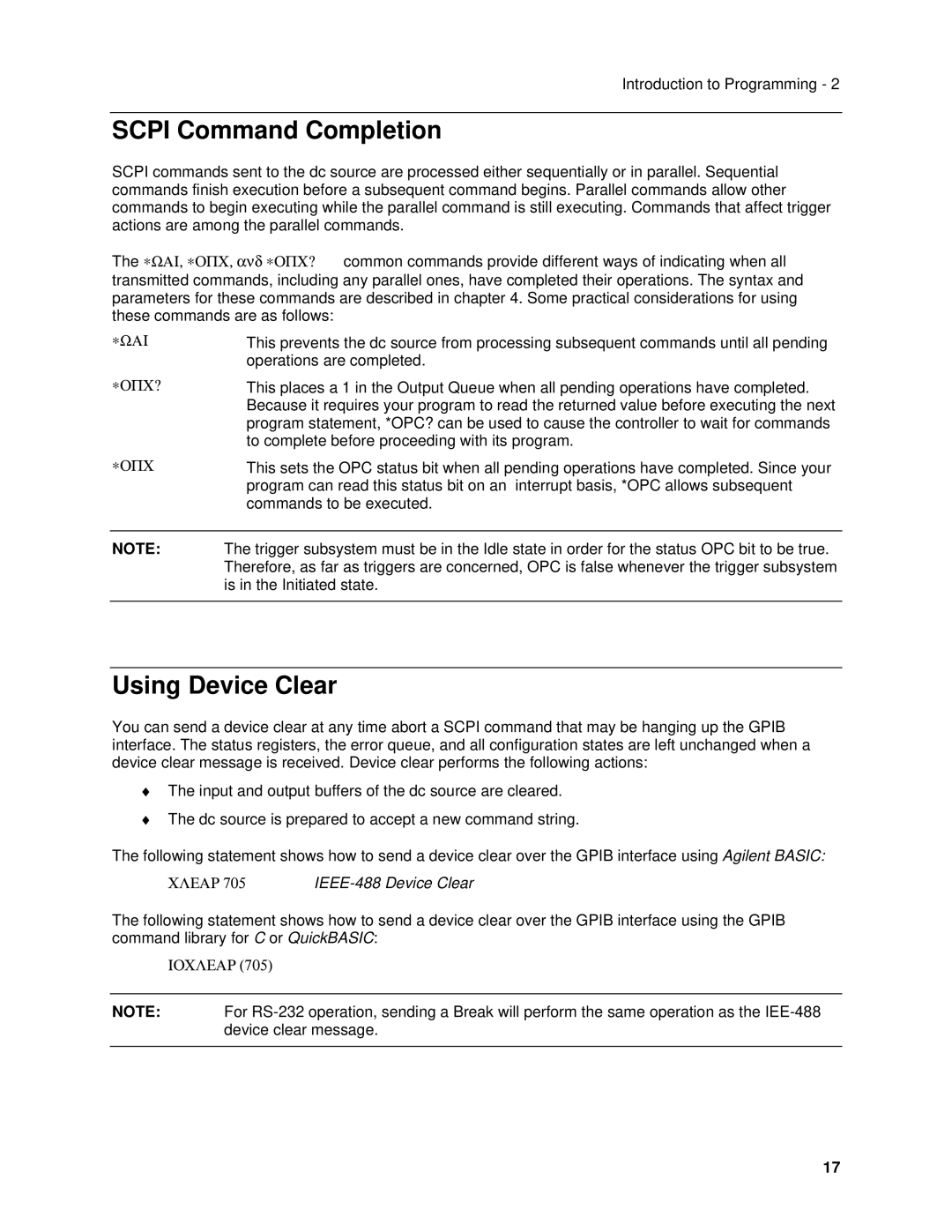Programming Guide
Printing History
Safety Guidelines
Table of Contents
Internally Triggered Measurements
Language Dictionary
Output Commands
Scpi Conformance Information
Error Messages
Compatibility Language
Example Programs
Documentation Summary
About this Guide
Scpi References
External References
Gpib References
Downloading and Installing the Driver
VXIplug&play Power Products Instrument Drivers
Supported Applications
System Requirements
Gpib Capabilities of the DC Source
Accessing Online Help
RS-232 Capabilities of the DC Source
Gpib Address
Baud Rate
RS-232 Flow Control
RS-232 Programming Example
Introduction to Scpi
RS-232 Troubleshooting
Conventions Used in This Guide
Boldface font
Multiple Commands in a Message
Types of Scpi Commands
Using Queries
Including Common Commands
Types of Scpi Messages
Moving Among Subsystems
Message Unit
Query Indicator
Headers
Message Unit Separator
Numerical Data Formats
Scpi Data Formats
Suffixes and Multipliers
Response Data Types
Using Device Clear
Scpi Command Completion
Page
Introduction
Power-on Initialization
Programming the Output
Enabling the Output
Output Current
Output Voltage
Maximum Voltage
Maximum Current
Triggering Output Changes
Setting the Voltage or Current Trigger Levels
Scpi Triggering Nomenclature
Output Trigger System Model
Generating Triggers
Initiating the Output Trigger System
DC Measurements
Making Measurements
Voltage and Current Measurements
Current Ranges
RMS Measurements Agilent 66312A, 66332A Only
Sequence Form Alias SEQuence2 ACQuire
Internally Triggered Measurements
Measurement Trigger System Model
BUS
Generating Measurement Triggers Agilent 66312A, 66332A Only
Trigger Commands Used to Measure Output Pulses
Pulse Measurement Queries
Measuring Output Pulses Agilent 66312A, 66332A Only
Current Detector
Multiple Measurements Agilent 66312A, 66332A Only
Controlling Measurement Samples
Varying the Voltage or Current Sampling Rate
Pre-event and Post-event Triggering
Pulse Measurement Example Agilent 66312A, 66332A only
Option Base
Programming the Status Registers
Power-On Conditions
Operation Status Group
Status Byte Register
Questionable Status Group
Standard Event Status Group
Servicing Operation Status and Questionable Status Events
Determining the Cause of a Service Interrupt
MSS Bit
RQS Bit
Monitoring Both Phases of a Status Transition
Inhibit/Fault Indicator
Discrete Fault Indicator DFI
Remote Inhibit RI
Bit Weight
Using the Inhibit/Fault Port as a Digital I/O
DFI Programming Example
Pin
Page
Language Dictionary
Subsystem Commands
Subsystem Commands Syntax
ALC
DFI
Subsystem Commands Syntax
Common Commands Syntax
Common Commands
Programming Parameters
Output Programming Parameters
CALibrateCURRent
Calibration Commands
CALibrateCURRentNEGative
CALibrateCURRentMEASureLOWRange
Command Syntax CALibrateSAVE Parameters None Examples
CALibratePASSword
CALibrateDATA
CALibrateLEVel
CALibrateVOLTage
CALibrateSTATe
CALibrateVOLTagePROTection
Query Syntax CALibrateSTATe?
MEASureARRayCURRent? FETChARRayCURRent?
Measurement Commands
MEASureARRayVOLTage? FETChARRayVOLTage?
Query Syntax
MEASureCURRentACDC? FETChCURRentACDC?
MEASureCURRent? FETChCURRent?
MEASureCURRentHIGH? FETChCURRentHIGH?
FETChCURRent? applies to Agilent 66312A, 66332A Only
MEASureCURRentMINimum? FETChCURRentMINimum?
MEASureCURRentLOW? FETChCURRentLOW?
MEASureCURRentMAXimum? FETChCURRent MAXimum?
MEASureVOLTageACDC? FETChVOLTageACDC?
MEASureVOLTage? FETChVOLTage?
MEASureVOLTageHIGH? FETChVOLTageHIGH?
FETChVOLTage? applies to Agilent 66312A, 66332A Only
MEASureVOLTageMINimum? FETChVOLTageMINimum?
MEASureVOLTageLOW? FETChVOLTageLOW?
MEASureVOLTageMAXimum? FETChVOLTageMAXimum?
SENSeCURRentDETector
SENSeCURRentRANGe
Unit a amperes *RST Value MAX high range
Returned Parameters NR3
SENSeSWEepOFFSetPOINts
SENSeFUNCtion
SENSeSWEepPOINts
SENSeSWEepTINTerval
HANNing
SENSeWINDow
RECTangular
Returned Parameters CRD
OUTPut
Output Commands
OUTPutDFI
OUTPutDFISOURce
OUTPutPROTectionCLEar
OUTPutPROTectionDELay
OUTPutPONSTATe
OUTPutRELayPOLarity
OUTPutRELay
OUTPutRIMODE
Query Syntax OUTPputRELayPOLarity?
SOURceCURRent
Default Suffix
SOURceCURRentTRIGger
SOURceCURRentPROTectionSTATe
SOURceDIGitalFUNCtion
SOURceDIGitalDATA
SOURceVOLTage
Query Syntax SOURceDIGitalDATA?
SOURceVOLTageTRIGger
SOURceVOLTageALCBANDwidth? SOURceVOLTageALCBWIDth?
SOURceVOLTagePROTection
Agilent 66332A, 6631B, 6632B, 6633B and 6634B Only
STATusPRESet
Status Commands
STATusOPERation?
STATusOPERationCONDition?
Query Syntax STATusOPERationENABle?
STATusOPERationENABle
Parameters Preset Value
STATusOPERationNTR STATusOPERationPTR
STATusQUEStionableCONDition?
STATusQUEStionableENABle
STATusQUEStionable?
STATusQUEStionableNTR STATusQUEStionablePTR
Command Syntax *CLS Parameters None
CLS
STATQUESNTR?STATQUESPTR?
ESE
Bit Configuration of Standard Event Status Enable Register
ESR?
OPC
SRE
PSC
PSC on
Example
STB?
Bit Configuration of Status Byte Register
WAI
NR1 register binary value
DISPlay
System Commands
DISPlayMODE
DISPlayTEXT
SYSTemLANGuage
SYSTemERRor?
SYSTemVERSion?
Parameters none Returned Parameters NR2
SYSTemREMote
SYSTemLOCal
SYSTemRWLock
IDN?
OPT?
Command Syntax RCL NRf Parameters Example
RCL
RST
Command Syntax SAV NRf Parameters Example
RST Settings
SAV
TST?
ABORt
Trigger Commands
INITiateSEQuence INITiateNAME
INITiateCONTinuousSEQuence1 INITiateCONTinuousNAME
TRIGgerSOURce
TRIGger
TRIGgerSEQuence2 TRIGgerACQuire
Abor Currtrig Init *TRG Volttrig
TRIGgerSEQuence2COUNtVOLTage TRIGgerACQuireCOUNtVOLTage
TRIGgerSEQuence2COUNtCURRent TRIGgerACQuireCOUNtCURRent
Parameters RST Value Examples
TRIGSEQ2COUNCURR 5 Trigacqcouncurr
TRIGSEQ2HYSTCURR TRIGSEQ2LEVVOLT
TRIGSEQ2HYSTVOLT TRIGSEQ2LEVCURR
TRIGgerSEQuence2LEVelVOLTage TRIGgerACQuireLEVelVOLTage
TRIGgerSEQuence2LEVelCURRent TRIGgerACQuireLEVelCURRent
TRIGSEQ2LEVVOLT TRIGSEQ2HYSTCURR
TRIGSEQ2LEVCURR TRIGSEQ2HYSTVOLT
TRIGSEQ2SLOPVOLT
TRIGgerSEQuence2SLOPeCURRent TRIGgerACQuireSLOPeCURRent
TRIGgerSEQuence2SLOPeVOLTage TRIGgerACQuireSLOPeVOLTage
TRIGgerSEQuence2SOURce TRIGgerACQuireSOURce
Parameters None Related Commands
TRIGgerSEQuence1DEFine TRIGgerSEQuence2DEFine
TRG
Page
Scpi Version
Scpi Confirmed Commands
Non-SCPI Commands
Page
Command Setting
Table B-1. COMPatibility Power-on Settings Command
ERR? FAULT? ID? IOUT?
Table B-2. COMPatibility Commands Compatibility
Similar Scpi Command
ASTS? CLR
Table B-2. COMPatibility Commands Description Similar Scpi
Compatibility Command
Compatibility Description Command
Table B-2. COMPatibility Commands
These commands determine the conditions that will set bits
Error
FAU
Norm Fast INH ERR UNR +CC
RQS ERR RDY
Page
Bit Set Error Number Error Code Error Type
Error Number List
Table C-1. Error Numbers
Error Number
Page
Types of DOS Drivers
Assigning the Gpib Address in Programs
Agilent 82335A Driver
National Instruments Gpib Driver
Basic Controllers
Error Handling
Example Programs D
Call IBCLRPS%
Example 2. IBM Controller Using National Interface
CODES$=*CLS
Option Base
Example 3. Controller Using Basic
Index
100
Index
Scpi
101
102
Manual Updates

